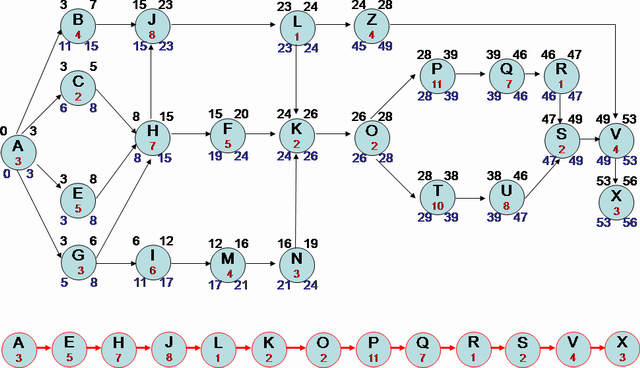Introduction
The Critical Path Method or just CPM is a mathematically based algorithm for scheduling a set of project activities.
Background
The essential technique for using CPM is to construct a model of the project that includes the following:
- A list of all activities required to complete the project (also known as Work Breakdown Structure)
- The time (duration) that each activity will take to completion, and
- The dependencies between the activities
For a test case, let's assume the following picture:

In the picture above, we have circles that represent activities identified by capitalized letters.
The red number inside each circle indicates the time spent to complete the activity.
The upper left and right numbers represent the earliest start time and earliest end time of each activity respectively. The lower left and right numbers represent the latest start time and latest end time of each activity respectively.
The circles with a red border represent the critical path for this given set of activities.
Using the Code
A class that represents each activity was firstly modelled. This class has as properties the activity's ID, description and duration along with the earliest start time (est), latest start time (lst), earliest end time (eet) and latest end time (let).
The dependencies between each activity are stored in two arrays, the successors and predecessors arrays.
public class Activity
{
private string id;
private string description;
private int duration;
private int est;
private int lst;
private int eet;
private int let;
private Activity[] successors;
private Activity[] predecessors;
...
}
The CPM algorithm uses the activities data to calculate the longest path of planned activities to the end of the project, and the earliest and latest that each activity can start and finish without making the project longer. This process determines which activities are "critical" (i.e., on the longest path) and which have "total float" (i.e., can be delayed without making the project longer).
To accomplish that, two methods were created: one called WalkListAhead and the other called WalkListAback.
The WalkListAhead method receives the array that stores the activities and performs the forward walking inside the array calculating for each activity its earliest start time and earliest end time.
After the forward walking, the WalkListAback performs the backward walking calculating for each activity its latest start time and latest end time.
The WalkListAhead and WalkListAback methods implementation:
private static Activity[] WalkListAhead(Activity[] list)
{
list[0].Eet = list[0].Est + list[0].Duration;
for(int i = 1; i < na; i++)
{
foreach(Activity activity in list[i].Predecessors)
{
if(list[i].Est < activity.Eet)
list[i].Est = activity.Eet;
}
list[i].Eet = list[i].Est + list[i].Duration;
}
return list;
}
private static Activity[] WalkListAback(Activity[] list)
{
list[na - 1].Let = list[na - 1].Eet;
list[na - 1].Lst = list[na - 1].Let - list[na - 1].Duration;
for(int i = na - 2; i >= 0; i--)
{
foreach(Activity activity in list[i].Successors)
{
if(list[i].Let == 0)
list[i].Let = activity.Lst;
else
if(list[i].Let > activity.Lst)
list[i].Let = activity.Lst;
}
list[i].Lst = list[i].Let - list[i].Duration;
}
return list;
}
To calculate the critical path, a method called CriticalPath verifies if each activity's earliest end time minus the latest end time and earliest start time minus the latest start time are equal zero. If so, the activity is part of the critical path and its Id is written in the screen. The project's total duration is also shown.
The CriticalPath method implementation:
void CriticalPath(Activity[] list)
{
Console.Write"\n Critical Path: ");
foreach(Activity activity in list)
{
if((activity.Eet - activity.Let == 0) && (activity.Est - activity.Lst == 0))
Console.Write("{0} ", activity.Id);
}
Console.Write("\n\n Total duration: {0}\n\n", list[list.Length - 1].Eet);
}
Running the Test Case
This is the output when the test case pertaining to the above picture is executed:

History
- Originally posted on my blog on 12/18/2007
